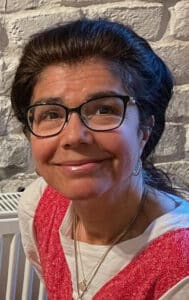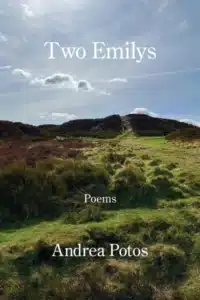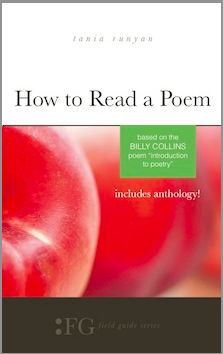
Andrea Potos pays homage to Emily Bronte and Emily Dickinson.
Emily Bronte (1818-1848) and Emily Dickinson (1830-1886) had more in common than their first names. Bronte published her classic Wuthering Heights under the pen name of Ellis Acton; Dickinson was little known, publishing only one letter and only 10 poems in her lifetime. Both became famous under their own names after they died. They lived in a time when women writers were not freely published.

Andrea Potos
Poet Andrea Potos knows the work of both writers, and in her new poetry collections, Two Emilys, she pays tribute to them. The collection’s 30 poems recognize what these two women, who lived their entire lives in the 19th century, mean to Potos herself and women in the 21st. She displays a fondness, yes, but also a sense of the debt women writers owe them.
Potos walks Bronte’s Yorkshire moor, finding a blue stone, and inspects the Bronte House Museum. She visits the Emily Dickinson Museum. She finds three acorns in the yard from Emily’s tree; whose yard is unspecified. She remembers reading Wuthering Heights at 11 years old, and she recalls her own college self working at a bookstore and selling a biography of Dickinson. She hears about people making pilgrimages to Dickinson’s home in Amherst, Mass., and mentally draws a portrait of Bronte helping clean the parsonage where the family lives.
And Potos discovers what it means to be in Dickinson’s room, and to want more than just being there..
Studio Sessions
(Emily Dickinson Museum)

may be nothing for the chance
to sit (given one small table and chair)
breathing the air of her room.
Surely some atoms of her being still
linger, though the counterpane
would be new, the lace curtains
pristinely laundered since her touch.
With only pencil and paper (no touching
of the furnishings allowed), how would it be to live
in the aftermath of her? Would she guide
my hand across the modern page?
Could I float along the lost thermals
of her thought? Would ambition keep me
stalled, forgetting how it was
the nobodies she favored.
She evens find some space for a poem about Emily’s sister, Charlotte, the author of Jane Eyre, and follows Dickinson on Apple TV and meets Bronte at the gym.
Potos is the author of numerous poetry collections. Her poems have been featured in a considerable number of print and online literary publications, and three of her books have received Outstanding Achievement Awards in Poetry from the Wisconsin Library Association. She’s also received the William Stafford Prize in Poetry from Rosebud Magazine and the James Heart Poetry Prize from North American Review. She lives in Madison, Wisconsin.
If you a fan of Bronte and Dickinson, or simply enjoy reading their work, you’ll be charmed by Two Emilys. And perhaps inspired to write your own tribute.
Related:
Andrea Potos and Her Joy Becomes.
Andrea Potos and Marrow of Summer.
Photo by Sebastiano Rametta, Creative Commons, via Flickr. Post by Glynn Young.
How to Read a Poem uses images like the mouse, the hive, the switch (from the Billy Collins poem)—to guide readers into new ways of understanding poems. Anthology included.
“I require all our incoming poetry students—in the MFA I direct—to buy and read this book.”
—Jeanetta Calhoun Mish
- Poets and Poems: Donna Vorreyer and “Unrivered” - October 7, 2025
- Poet Sidney Lanier and the Lost Cause - October 2, 2025
- Poets and Poems: A.J. Thibault and “We Lack a Word” - September 30, 2025


Bethany R. says
Thanks for highlighting this poet and collection. I’ve enjoyed Andrea Potos’ poetry in the past and this featured poem is a treat as well. Now, I’m thinking of being in that room of Emily’s and how at least the angle of light coming through the window would potentially be the same as she would have observed. (Surely, she spent time looking out windows, as all poets do.)
And that makes me think of where I am right now, seated at the desk in my kitchen with a window to my left, and who else might have sat, or more likely, walked through this spot 150 years ago. What we have in common with strangers from the past and what’s unique to our experiences and perspectives.
Glynn says
Bethany, I’ve been thinking lately about the the DNA that has flowed to me and on to my children and grandchildren, DNA from People who came over on the Mayflower, the group dumped on the Georgia beaches, fresh out of debtor’s prison, the German immigrants who came to New Orleans and found themselves in a Union-occupied city, the people expelled from Acadia (Nova Scotia), the Irish men and women who fled the potato famine — it’s all there.